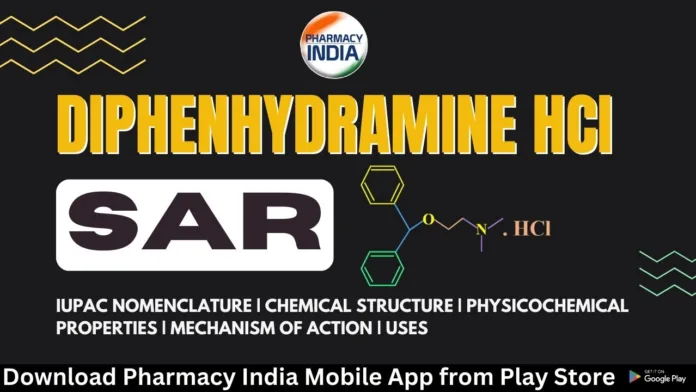IUPAC nomenclature
2-(diphenylmethoxy)-N,N-dimethylethanamine
Chemical Structure

Physicochemical Properties
1. Chemical Formula: C17H21NO·HCl
2. Molecular Weight: 291.82 g/mol
3. Solubility: Diphenhydramine HCl is soluble in water, alcohol, and chloroform. Its solubility in water makes it suitable for oral administration in various formulations such as tablets, capsules, and syrups.
4. Melting Point: The melting point of diphenhydramine HCl typically ranges between 168-175°C (334-347°F).
5. pKa: Diphenhydramine is a weak base. The pKa (acid dissociation constant) of diphenhydramine is around 9.0, indicating that it is ionized to a significant extent in acidic solutions.
6. Appearance: Diphenhydramine HCl is usually found as a white, crystalline powder or as colorless crystals. It is odorless and has a bitter taste.
7. Stability: It should be stored in a tightly closed container, protected from light, in a cool, dry place. The drug is stable under normal conditions but may degrade if exposed to extreme heat, moisture, or light.
Structural Activity Relationship (SAR)
1. Diphenylmethane Backbone: Diphenhydramine contains a diphenylmethane backbone, which is essential for its activity. This structural is common in many first-generation antihistamines and is thought to be responsible for their H1 receptor antagonism. By blocking histamine receptors, diphenhydramine helps in relieving allergy symptoms.
2. Alkylamine Side Chain: Diphenhydramine has an alkylamine side chain, which is a characteristic feature of first-generation antihistamines. This side chain is important for interacting with histamine receptors and is believed to be crucial for the antagonist activity at the H1 receptor site.
3. Ether Linkage: The presence of an ether linkage (-O-) in diphenhydramine contributes to its stability and overall structure. This linkage is not directly involved in receptor interactions but is important for maintaining the integrity of the molecule.
4. Tertiary Amine Group: The tertiary amine group (a nitrogen atom attached to three alkyl groups) in diphenhydramine is essential for its pharmacological activity. It is this amine group that can be protonated to form a positively charged species, allowing diphenhydramine to interact with negatively charged sites on histamine receptors.
5. Substituents on the Aromatic Rings: The specific substituents on the aromatic rings of diphenhydramine can influence its potency and selectivity for histamine receptors. Different substitutions can lead to variations in activity and side effects.
6. Chloride Ion: In the form of diphenhydramine hydrochloride (HCl), the chloride ion does not directly participate in receptor interactions but plays a role in the salt formation of the drug, making it more stable and suitable for pharmaceutical use.
Mechanism of Action
Histamine exerts its effects by binding to specific receptors on cells, particularly the H1 receptors. When histamine binds to these receptors, it causes various allergic symptoms such as itching, sneezing, and nasal congestion. Diphenhydramine is an H1 receptor antagonist, meaning it competes with histamine for binding to the H1 receptors on target cells. By blocking these receptors, diphenhydramine prevents histamine from exerting its effects.
Uses
1. Heartburn
2. Stomach Ulcer
3. Acid Reflux
Cimetidine SAR, Physicochemical Properties, IUPAC Nomenclature, Mechanism of action and Uses







